Cholesterol – Just Make Your Own
Alberts, B., Johnson, A., & Lewis, J. et al. (2014). Molecular Biology of the Cell. Garland Science.
Provides a detailed overview of cholesterol’s roles in cell membranes, hormone production, and metabolic pathways.
Berg, J. M., Tymoczko, J. L., & Stryer, L. (2015). Biochemistry. W. H. Freeman.
Explores cholesterol synthesis, regulation, and its systemic impacts on human physiology.
Taiz, L., Zeiger, E., Møller, I. M., & Murphy, A. (2015). Plant Physiology and Development. Sinauer Associates.
Discusses the role of sterols in plants and their evolutionary parallels in animal systems.
Lütjohann, D., Meyer, S., & von Bergmann, K. (1993). “Cholesterol metabolism in humans: Regulation of synthesis and absorption.” Biochimica et Biophysica Acta (BBA) – Lipids and Lipid Metabolism, 1167(3), 232–241.
Details the biochemical pathways involved in cholesterol synthesis, highlighting mechanisms of homeostatic regulation critical to maintaining metabolic balance.
Brown, M. S., & Goldstein, J. L. (1986). “A receptor-mediated pathway for cholesterol homeostasis.” Science, 232(4746), 34–47.
Describes the LDL receptor-mediated pathway for cholesterol homeostasis, highlighting how receptor regulation controls cholesterol absorption, synthesis, and systemic lipid balance.
Goldstein, J. L., & Brown, M. S. (1990). “Regulation of cholesterol metabolism.” Science, 248(4958), 425–431.
Explains how cholesterol metabolism is tightly regulated, detailing the mechanisms governing cholesterol synthesis, cellular uptake, and its systemic role in lipid homeostasis.
Hu, F. B., & Willett, W. C. (2002). “Optimal diets for prevention of coronary heart disease.” JAMA, 288(20), 2569–2578.
Discusses how dietary cholesterol and saturated fats significantly influence cardiovascular risk, emphasising dietary strategies for the prevention of coronary heart disease.
Grundy, S. M. (1997). “What is the desirable ratio of saturated, polyunsaturated, and monounsaturated fatty acids in the diet?” The American Journal of Clinical Nutrition, 66(4 Suppl), 988S–990S.
Discusses how the balance of dietary fats affects cholesterol metabolism, systemic inflammation, and overall cardiovascular health.
Anderson, J. W., Spencer, D. B., & Hamilton, C. C. (1990). “Dietary fibre and lipid metabolism: The role of bile acid excretion.” The American Journal of Clinical Nutrition, 51(5), 778–785.
Discusses how dietary fibre binds bile acids, facilitating their excretion and enhancing cholesterol clearance to support systemic lipid metabolism.
Reynolds, A., Mann, J., Cummings, J., et al. (2019). “Carbohydrate quality and human health: A series of systematic reviews and meta-analyses.” The Lancet, 393(10170), 434–445.
Quantifies the significant cholesterol-lowering effects of fibre-rich dietary patterns, highlighting their importance in reducing cardiovascular disease risk.
Libby, P. (2002). “Inflammation in atherosclerosis.” Nature, 420(6917), 868–874.
Examines the inflammatory pathways triggered by elevated LDL cholesterol, highlighting how this immune activation contributes to atherosclerotic plaque formation and cardiovascular disease.
Ross, R. (1999). “Atherosclerosis—An inflammatory disease.” The New England Journal of Medicine, 340(2), 115–126.
Explores the inflammatory cascade triggered by lipid accumulation, detailing how immune responses lead to arterial stiffening, plaque formation, and increased cardiovascular risk.
Tabas, I., Williams, K. J., & Borén, J. (2007). “Subendothelial lipoprotein retention as the initiating process in atherosclerosis.” Circulation, 116(16), 1832–1844.
Examines how LDL cholesterol accumulation in arterial walls initiates and accelerates plaque formation, highlighting the critical early steps in atherosclerotic disease progression.
Esselstyn C. B. (2017). A plant-based diet and coronary artery disease: a mandate for effective therapy. Journal of geriatric cardiology : JGC, 14(5), 317–320.
Provides clinical evidence showing that plant-based diets can reverse plaque buildup and restore arterial function.
